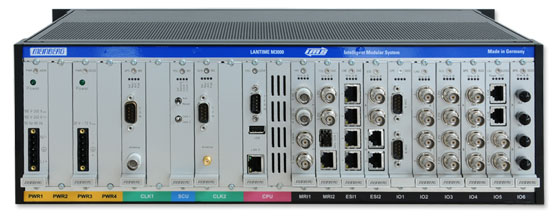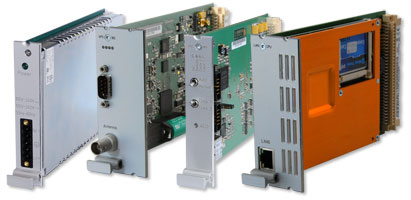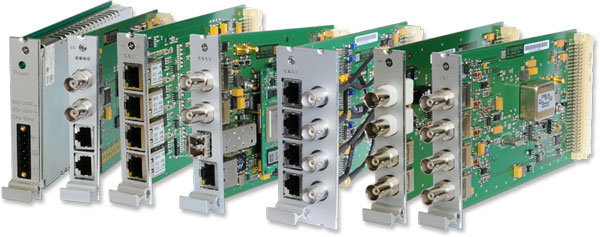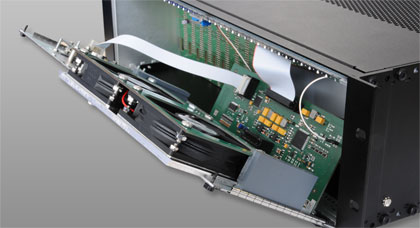Meinberg Lantime M3000 – The new Synchronisation Centre for your Application
Today Meinberg announced the general availability of their newest member of the Lantime family of network synchronisation servers. The all new Lantime M3000 is a 3U rack mount system with a fully modular approach. This modularity supports forming highly customised synchronisation systems by combining standard building blocks, resulting in one of the most cost-effective yet ultra-versatile synchronisation solution on the market.

The M3000 is the first product in Meinberg’s new IMS Series (Intelligent Modular Systems), offering built-in redundancy for synchronisation sources, power supplies and cooling in combination with a highly modular slot based chassis supporting hot-swapping and field expansion capabilities. The 18 slot 3U rack-mount design of the Lantime M3000 allows the use up to 4 power supplies, two clock modules, a switch module, a CPU board and 10 I/O slots.
Meinberg’s brand new IMS power supplies have been custom made with high efficiency in mind, the two models currently available support either 100-240VAC/VC or 18-72VDC and it is possible to populate the four PWR slots with a combination of both AC and DC power supplies.
Full redundancy is also available for the clock boards, which form the core element in a Lantime system. Each clock module has an integrated highly stable oscillator that is disciplined by reference sources like GPS or GLONASS satellites or other signals, for example 1PPS, 10MHz, E1/T1 as well as IRIG Time Codes. The Meinberg MRS concept built into the IMS platform allows selecting of one or more network reference sources like NTP or PTP and all of these time and frequency references can be utilised in a user-defined priority order.
Each M3000 comes with two CLK slots and a new RSC slot. The M3000 supports a single clock module configuration as well as a fully redundant setup, including a combination of different CLK modules like the Meinberg GPS180 and the GLN180 combined GPS/GLONASS receiver board. If both CLK slots are populated, the new RSC switch card is required to handle smooth transitions from the primary clock module to the backup module in case of a failure or loss of synchronisation. The RSC module can work in automatic mode and can be manually controlled, if required.
As the central management hub, the CPU module is one of the core elements of the Lantime M3000. It runs the management and configuration interfaces and is also responsible for alarm notifications and status information. As with all Lantime systems, the M3000 CPU board provides highly accurate and reliable NTP synchronisation to any SNTP or NTP compatible client.

The CPU module runs Meinberg’s Lantime V6 firmware that is common to all members of the Lantime family from the compact rail-mount Lantime M100 to the full featured highly customizable M300 and M900 models. The LTOS V6 firmware platform offers a newly designed web UI as well as a powerful SNMP management interface for a perfect integration of the Lantime into your central network management system. The NTP performance of the C051F CPU module allows it to respond to up to 10,000 NTP requests per second.
Being the first IMS enabled product, the Lantime M3000 offers 10 I/O slots. While all of these slots can be populated with a user-selectable combination of IMS I/O modules, the first four of them can alternatively be used for additional reference input cards. Each of the two clock boards of the M3000 can be expanded with one MRI and one ESI input card or even two ESI cards.
While the MRI card supports the typical MRS input sources like 1PPS, 10MHz, DCLS and AM Time codes (IRIG/AFNOR/IEEE1344 C37.118), the ESI module accepts variable frequencies (1kHz-10MHz), 1PPS and E1/T1 signals for telecommunication applications. The E1/T1 framed signal input fully supports SSM/BOC information and correctly passes this information on to any E1/T1 output card (IMS-LIU).
All ten I/O slots support any combination of the available I/O output modules. The selection of IMS output modules provides a stunning selection of output signals, but will be expanded in the future to add more signals and physical interfaces as needed. The telecom specific LIU output module offering up to 8 E1/T1 outputs and the low-phase-noise 10MHz Sine wave LNO module for broadcasting applications are among the IMS modules that are already available at market launch.
The standard output signals like pulses (1PPS, 1PPM and freely programmable pulses) and frequencies (10MHz, 2.048MHz, frequency synthesizer 1 kHz-10MHz) are provided by two versatile I/O cards named BPE and CPE. Both of these two modules have been designed to cover a wide range of interface and signal/protocol requirements. They feature a two-tier architecture with a backend and front-end. While the back-end is responsible for internally routing the backplane IMS synchronisation signals (in case of the BPE) or for autonomously generating a wide range of different signals by using a microprocessor (on a CPE), the front-end makes a selection of the signals available on physical connectors. Due to this design, it is very easy to support a large number of different electrical or optical physical interfaces, like BNC, SMA, Twinax, 2-pin DFK, DSUB9 and ST/SC FO connectors.
Nearly all modules for the M3000 system are hot-swappable as well as field-replaceable. The end user can easily expand their synchronisation solution by adding more modules to the M3000 when required, making this one of the most scalable and flexible synchronisation solutions available today.
The I/O slots of the M3000 can also be used to add additional network interfaces by using one of the IMS LNE cards with either 4x10/100 Ethernet or 4x 10/100/1000 Ethernet ports. The theoretically supported maximum number of Ethernet interfaces is 41 ports (10xLNEx4 Ports +1 CPU port), allowing all kinds of different network layouts and separation of physical segments. The LTOS V6 bonding feature enables the user to configure high availability network connections with redundant physical links in order to survive cable and switch failures without a service interruption.

Fig.: The I/O Modules for the LANTIME M3000
IEEE1588 (Precision Time Protocol, PTP) applications are supported by the new IMS-TSU module with a combined RJ45/SFP Gigabit Ethernet port and an integrated powerful 1GHz dual core service processor, allowing to synchronise hundreds of PTP slave clocks. The Meinberg IMS-TSU module is one of the most flexible PTP solutions on the market, supporting 1-step and 2-step mode, Layer 2 (Ethernet), Layer 3 (IPv4 and IPv6), End-to-End and Peer-to-Peer Delay measurements as well as Unicast, Multicast and Hybrid modes.
The Meinberg PTP implementation supports default profile as well as telecom profile, enterprise profile and power profile operation. An IMS-TSU module can be configured to act as a Master-only port, a Slave-only port or dynamically switch between these modes (Ordinary Clock). When running in slave mode, the board can be used as a synchronisation reference and synchronises to an external PTP master on the network. Each M3000 can be populated with up to 10 IMS-TSU modules, with each module being able to support an independent configuration.
The Lantime M3000 is also available with an Active Cooling Module (ACM) with redundant fans and integrated temperature and status monitoring. It is designed however to be operated in a fan-less configuration as long as there is enough rack space to allow airflow from the bottom to the top cover of the chassis. Fans, if required, can be added at any time and are field-replaceable in case of a failure.
The chassis concept of the M3000 ensures that main connectivity is provided on one single side. This includes power input as well as all synchronisation and network input/output interfaces. The front panel with the backlit LC display, service USB port as well as the serial console port also offers access to the ACM fan cartridge slot and to the menu buttons for operating the LCD menus, if required. It is possible to use the rack mounting brackets on both sides of the Lantime M3000 chassis.



